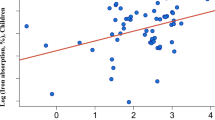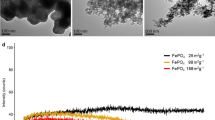Abstract
Background/Objectives:
Ferrous fumarate is recommended for the fortification of complementary foods based on similar iron absorption to ferrous sulfate in adults. Two recent studies in young children have reported that it is only 30% as well absorbed as ferrous sulfate. The objective of this study was to compare iron absorption from ferrous fumarate and ferrous sulfate in infants, young children and mothers.
Subjects/Methods:
Non-anemic Mexican infants (6–24 months), young children (2–5 years) and adult women were randomly assigned to receive either 4 mg Fe (women) or 2.5 mg Fe (infants and young children) as either [57Fe]-ferrous fumarate or [58Fe]-ferrous sulfate added to a sweetened drink based on degermed maize flour and milk powder. Iron absorption was calculated based on incorporation of isotopes into erythrocytes after 14days.
Results:
Within each population group, no significant differences (P>0.05) in iron absorption were found between ferrous fumarate and ferrous sulfate. Mean iron absorption from ferrous fumarate vs ferrous sulfate was 17.5 vs 20.5% in women (relative bioavailability (RBV) =86), 7.0 vs 7.2% in infants (RBV = 97) and 6.3 vs 5.9% in young children (RBV = 106).
Conclusions:
Ferrous fumarate is as well absorbed as ferrous sulfate in non-anemic, iron sufficient infants and young children, and can be recommended as a useful fortification compound for complementary foods designed to prevent iron deficiency. Further studies are needed to clarify its usefulness in foods designed to treat iron deficiency.
This is a preview of subscription content, access via your institution
Access options
Subscribe to this journal
Receive 12 print issues and online access
$259.00 per year
only $21.58 per issue
Buy this article
- Purchase on Springer Link
- Instant access to full article PDF
Prices may be subject to local taxes which are calculated during checkout

Similar content being viewed by others
References
Brown E, Hopper J, Hodges JL, Bradley B, Wennesland R, Yamauchi H (1962). Red cell, plasma, and blood volume in healthy women measured by radiochromium cell-labeling and hematocrit. J Clin Invest 41, 2182–2190.
Davidsson L, Dimitriou T, Boy E, Walczyk T, Hurrell RF (2002). Iron bioavailability from iron-fortified Guatemalan meals based on corn tortillas and black bean paste. Am J Clin Nutr 75, 535–539.
Davidsson L, Galan P, Cherouvrier F, Kastenmayer P, Juillerat MA, Hercberg S et al. (1997). Bioavailability in infants of iron from infant cereals: effect of dephytinization. Am J Clin Nutr 65, 916–920.
Davidsson L, Galan P, Kastenmayer P, Cherouvrier F, Juillerat MA, Hercberg S et al. (1994). Iron bioavailability studied in infants - the influence of phytic acid and ascorbic-acid in infant formulas based on soy isolate. Pediatr Res 36, 816–822.
Davidsson L, Kastenmayer P, Szajewska H, Hurrell RF, Barclay D (2000). Iron bioavailability in infants from an infant cereal fortified with ferric pyrophosphate or ferrous fumarate. Am J Clin Nutr 71, 1597–1602.
Davidsson L, Walczyk T, Zavaleta N, Hurrell RF (2001). Improving iron absorption from a Peruvian school breakfast meal by adding ascorbic acid or Na(2)EDTA. Am J Clin Nutr 73, 283–287.
Davidsson L, Ziegler EE, Kastenmayer P, van Dael P, Barclay D (2004). Dephytinisation of soyabean protein isolate with low native phytic acid content has limited impact on mineral and trace element absorption in healthy infants. Br J Nutr 91, 287–294.
Fidler MC, Davidsson L, Zeder C, Walczyk T, Hurrell RF (2003). Iron absorption from ferrous fumarate in adult women is influenced by ascorbic acid but not by Na(2)EDTA. Br J Nutr 90, 1081–1085.
Fomon SJ (1987). Reflections on infant feeding in the 1970s and 1980s. Am J Clin Nutr 46, 171–182.
Fuchs GJ, Farris RP, DeWier M, Hutchinson SW, Warrier R, Doucet H et al. (1993). Iron status and intake of older infants fed formula vs cow milk with cereal. Am J Clin Nutr 58, 343–348.
Gavin M, McCarthy D, Garry P (1994). Evidence that iron stores regulate iron absorption–a setpoint theory. Am J Clin Nutr 59, 1376–1380.
Hosein F, Marsaglia G, Finch CA (1967). Blood ferrokinetics in normal man. J Clin Invest 49, 1–9.
Hurrell RF (1997). Preventing iron deficiency through food fortification. Nutr Rev 55, 210–222.
Hurrell RF, Furniss DE, Burri J, Whittaker P, Lynch SR, Cook JD (1989). Iron fortification of infant cereals: a proposal for the use of ferrous fumarate or ferrous succinate. Am J Clin Nutr 49, 1274–1282.
Hurrell RF, Reddy MB, Burri J, Cook JD (2000). An evaluation of EDTA compounds for iron fortification of cereal-based foods. Br J Nutr 84, 903–910.
Hurrell RF, Reddy MB, Burri J, Cook JD (2002). Phytate degradation determines the effect of industrial processing and home cooking on iron absorption from cereal-based foods. Br J Nutr 88, 117–123.
Linderkamp O, Versmold H, Riegel K, Betke K (1977). Estimation and prediction of blood volume in infants and children. Eur J Paediatr 125, 227–234.
Moretti D, Zimmermann MB, Wegmuller R, Walczyk T, Zeder C, Hurrell RF (2006). Iron status and food matrix strongly affect the relative bioavailability of ferric pyrophosphate in humans. Am J Clin Nutr 83, 632–638.
PAHO, FNP, USAID (2002). Iron fortification: where are we in terms of compounds. A technical consultation. Nutr Rev 60, S50–S61.
Perez-Exposito AB, Villalpando S, Rivera JA, Griffin IJ, Abrams SA (2005). Ferrous sulfate is more bioavailable among preschoolers than other forms of iron in a milk-based weaning food distributed by PROGRESA, a national program in Mexico. J Nutr 135, 64–69.
Sarker SA, Davidsson L, Mahmud H, Walczyk T, Hurrell RF, Gyr N et al. (2004). Helicobacter pylori infection, iron absorption, and gastric acid secretion in Bangladeshi children. Am J Clin Nutr 80, 149–153.
Walczyk T (1997). Iron isotope ratio measurements by negative thermal ionization mass spectrometry. Int J Mass Spectrom Ion Processes 161, 217–227.
Walczyk T, Davidsson L, Zavaleta N, Hurrell RF (1997). Stable isotope labels as a tool to determine iron absorption by Peruvian school children from a breakfast meal. Fresenius J Anal Chem 359, 445–449.
World Health Organization (2006). Guidelines on Food Fortification with Micronutrients. World Health Organization and Food and Agriculture Organization: Geneva.
Acknowledgements
We thank the women, children and infants for their participation in the study and Dr Marisela Almazon for her assistance. All authors contributed to the study design, data analysis and writing of the paper. MH, CH and GOP carried out the field work. SV, MBZ, TW, JAR and RFH supervised the field work, and CZ and TW were responsible for stable isotope analysis. MH wrote the first draft of the paper, and all authors contributed to its editing. The study was supported by the Micronutrient Initiative, Ottawa, Canada, the Swiss Federal Institute of Technology, Zürich, Switzerland and the Instituto Nacional de Salud Pública, Cuernavaca, Morelos, Mexico.
Author information
Authors and Affiliations
Corresponding author
Ethics declarations
Competing interests
The authors declare no conflict of interest.
Rights and permissions
About this article
Cite this article
Harrington, M., Hotz, C., Zeder, C. et al. A comparison of the bioavailability of ferrous fumarate and ferrous sulfate in non-anemic Mexican women and children consuming a sweetened maize and milk drink. Eur J Clin Nutr 65, 20–25 (2011). https://doi.org/10.1038/ejcn.2010.185
Received:
Revised:
Accepted:
Published:
Issue Date:
DOI: https://doi.org/10.1038/ejcn.2010.185
Keywords
This article is cited by
-
Micronutrient supplementation in pregnancies following bariatric surgery: a practical review for clinicians
Obesity Surgery (2021)
-
Polyphenol-rich tea decreases iron absorption from fortified wheat bread in Senegalese mother–child pairs and bioavailability of ferrous fumarate is sharply lower in children
European Journal of Clinical Nutrition (2020)
-
Refining Treatment Strategies for Iron Deficient Athletes
Sports Medicine (2020)
-
The bioavailability of iron picolinate is comparable to iron sulfate when fortified into a complementary fruit yogurt: a stable iron isotope study in young women
European Journal of Nutrition (2020)
-
Iron Therapy in Patients with Heart Failure and Iron Deficiency: Review of Iron Preparations for Practitioners
American Journal of Cardiovascular Drugs (2017)



